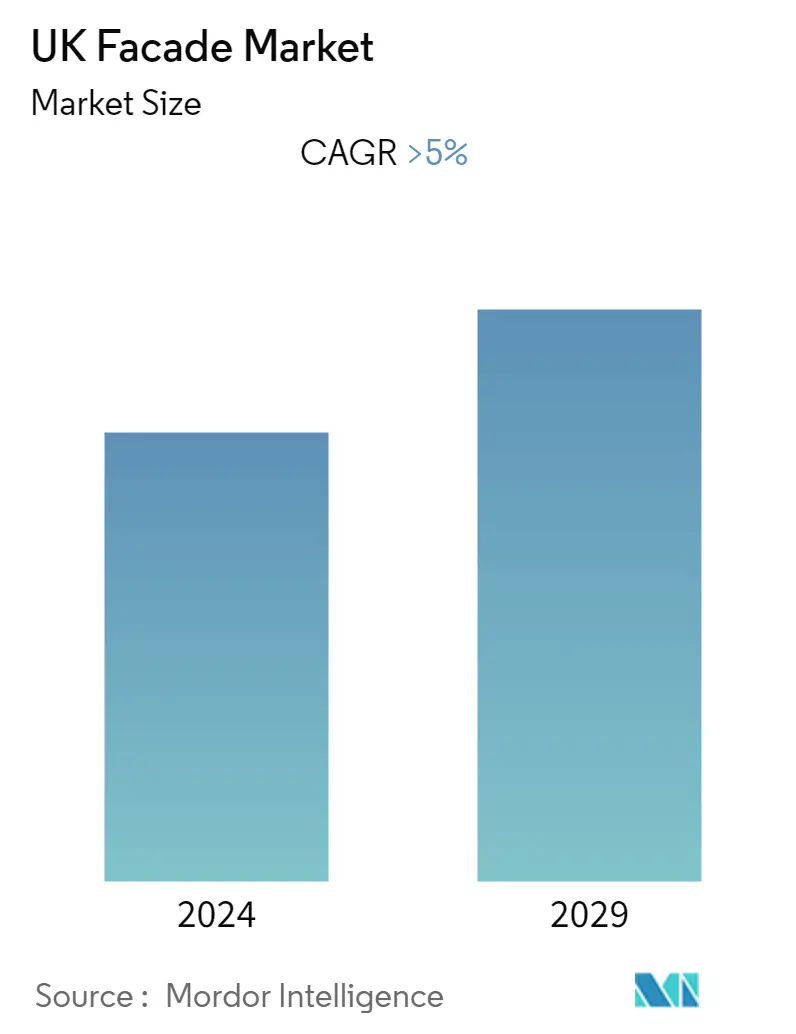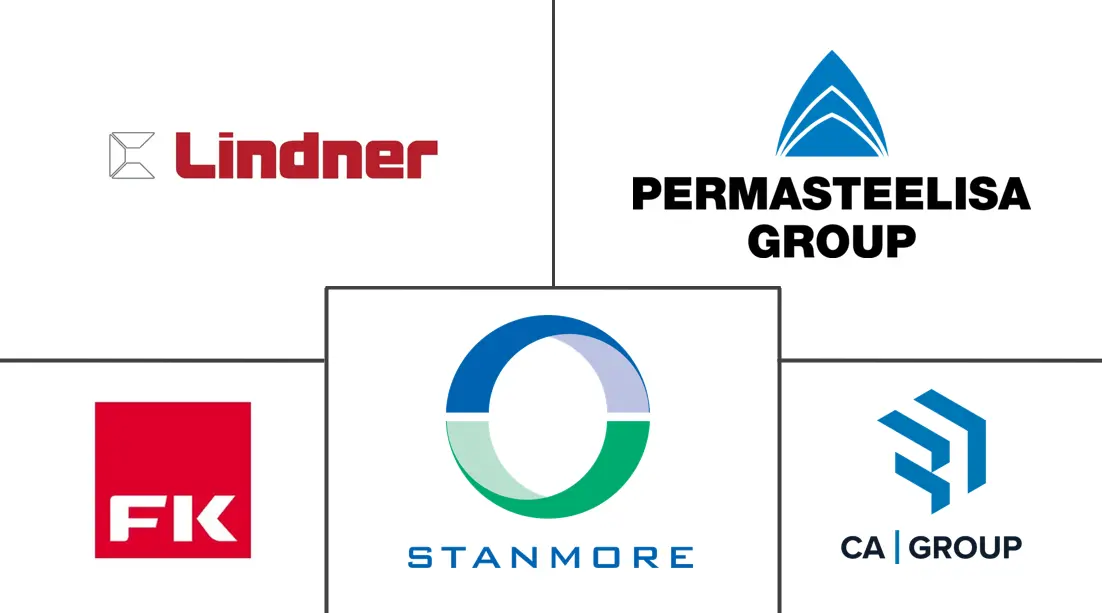Market Size of UK Facade Industry

| Study Period | 2020 - 2029 |
| Base Year For Estimation | 2023 |
| Forecast Data Period | 2024 - 2029 |
| Historical Data Period | 2020 - 2022 |
| CAGR | > 5.00 % |
| Market Concentration | Medium |
Major Players
*Disclaimer: Major Players sorted in no particular order |
Need a report that reflects how COVID-19 has impacted this market and its growth?
UK Facade Market Analysis
- The UK Facade Market is estimated to register a CAGR of greater than 5% during the forecast period (2023-2028). The construction industry in the UK was adversely impacted by the virus outbreak, with output declining by 14% in 2020. The COVID-19 pandemic has adversely impacted the construction and real estate industry subsequently, hampering the market growth. However, with the announcement of economic relief packages, the demand for facades increased in 2021-2022.
- Modernization and urbanization play a vital role in the market's growth. Several factors including waterproofing, fabrication, durability, and resistance to extreme climate come to play during the construction of facades. They determine consumer preferences for façade materials. Changing perceptions of consumers and increasing focus on the exterior appearance of a building will increase the demand in the market.
- Rising disposable income leads to increased investments in renovations, which, in turn, supports market advancement. Growing investments in the advancement of the residential and commercial construction industries can stoke the market's growth. The burgeoning popularity of green buildings and surging demand for high-transparency glasses that allow passage of light, while maintaining heat resistance, are poised to shape the future of the market. The market is projected to witness the application of high-performance and energy-saving solar control facades, which will contribute to higher economic benefits and eco-sustainability.
- Furthermore, the initiatives and regulations by government bodies, technological advancements, and the need for energy conservation are estimated to propel the market growth in the years to come. The soaring need to lower heating and air-conditioning costs and achieve energy efficiency is slated to stir up the demand for facades over the coming years.
- Growing focus on the development of sustainable products is likely to work in favor of the market. Incidences of severe building fires have prompted public concern over the safety of facade materials. Five years after the Grenfell fire in which 72 people died, the government banned the specific type of cladding that allowed the blaze to spread so rapidly. Metal composite panels with an unmodified polyethylene core now cannot be used on any building of any height. Facade materials play a vital role in fire safety as the outer part of the building is directly in contact with fire. Considering this façade materials will be strictly regulated in the future.
UK Facade Industry Segmentation
The word facade originally comes from the Italian word 'facciata' and is defined as the outside or all of the external faces of a building. The term is frequently used to refer just to the main or front face of a house. Along with the roof, it is one of the most important elements of a building, since it acts as the primary barrier against external weather elements that could damage the health of the structure, such as rain, snow, wind, frost, sun, etc.
The UK facade market is segmented By Type (Ventilated, Non-Ventilated, and Others), By Material (Glass, Metal, Plastic and Fibers, Stones, and Others), and By End Users (Commercial, Residential, and Others). The report offers market size and forecast in terms of value (USD Billion) for all the above segments.
| By Type | |
| Ventilated | |
| Non-ventilated | |
| Others |
| By Material | |
| Glass | |
| Metal | |
| Plastics and Fibres | |
| Stone | |
| Others |
| By Application | |
| Commercial | |
| Residential | |
| Others |
UK Facade Market Size Summary
The UK Facade Market is anticipated to grow at a steady pace in the coming years, driven by factors such as modernization, urbanization, and rising disposable income. The market's growth is further propelled by the increasing demand for facades due to their waterproofing, fabrication, durability, and resistance to extreme climate properties. The increasing focus on the exterior appearance of buildings and the growing popularity of green buildings are also contributing to the market's expansion. The application of high-performance and energy-saving solar control facades is expected to shape the market's future, offering higher economic benefits and eco-sustainability. Despite the positive outlook, the market is likely to face challenges due to the expected fall in construction output amid the looming UK economic recession. This fall is mainly due to the wider economic recession and the fallout from recent political uncertainty. However, the growing need for energy efficiency in buildings is expected to drive the market growth. Facades, being a significant contributor to energy expenses and the comfort parameters of any building, are gaining importance. The market is fragmented with several players, and the increasing popularity of facades in commercial construction is expected to create opportunities for new market entrants.
Explore MoreUK Facade Market Size - Table of Contents
-
1. MARKET INSIGHTS AND DYNAMICS
-
1.1 Current Market Scenario
-
1.2 Market Drivers
-
1.3 Market Restraints
-
1.4 Market Opportunities
-
1.5 Value Chain / Supply Chain Analysis
-
1.6 Industry Attractiveness - Porter's Five Forces Analysis
-
1.6.1 Threat of New Entrants
-
1.6.2 Bargaining Power of Buyers/Consumers
-
1.6.3 Bargaining Power of Suppliers
-
1.6.4 Threat of Substitute Products
-
1.6.5 Intensity of Competitive Rivalry
-
-
1.7 Insights on Changes in Consumer Behavior in the Market
-
1.8 Insights on Government Regulations in the Market
-
1.9 Insights on Technological Advancements in the Market
-
1.10 Impact of COVID-19 on the Market
-
-
2. MARKET SEGMENTATION
-
2.1 By Type
-
2.1.1 Ventilated
-
2.1.2 Non-ventilated
-
2.1.3 Others
-
-
2.2 By Material
-
2.2.1 Glass
-
2.2.2 Metal
-
2.2.3 Plastics and Fibres
-
2.2.4 Stone
-
2.2.5 Others
-
-
2.3 By Application
-
2.3.1 Commercial
-
2.3.2 Residential
-
2.3.3 Others
-
-
UK Facade Market Size FAQs
What is the current UK Facade Market size?
The UK Facade Market is projected to register a CAGR of greater than 5% during the forecast period (2024-2029)
Who are the key players in UK Facade Market?
Permasteelisa, Lindner Exteriors, FK Group, Stanmore and CA Group are the major companies operating in the UK Facade Market.
